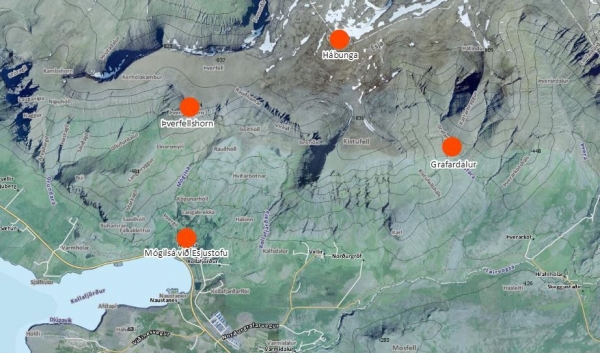Three hikers were caught in an avalanche in Mount Esja, north of Reykjavík on Friday. Two of the men managed to get out of the avalanche on their own. The third man was by search teams manned by ICE-SAR members from the capital region. He was pronounced dead at the National University Hospital.
The avalanche fell in Grafardalur valley on the eastern edge of the south slopes of the mountain at an altitude of 600 meters (2000 ft) above sea level. The avalanche took place in a very steep slope, 45° incline. Avalanches are quite common in the slopes of Esja.
Three men were following a well-known hiking path
ICE-SAR received the distress call at five on Friday afternoon. 130 search and rescue members were immediately dispatched to mount Esja, including snowmobiles, search dogs and the coast guard helicopter. The two of the men had managed to get out of the avalanche on their own were taken to the National University Hospital, and after rescue teams dug out the third man he was also to the emergency room of the National University Hospital. He was pronounced dead upon arrival. The other two men did not suffer serious injuries.
Read more: People tend to 'underestimate' Mt. Esja
According to the local news site Vísir the men were following a well-known hiking trail to the summit of the mountain, Hábunga. A local guide, Páll Guðmundsson, told the radio station Bylgjan that the mountain could be more dangerous than people assumed: It‘s proximity to the capital lulls people into a false sense of security.
More dangerous than people realize
Mount Esja is a 914 m (2,999 ft) high volcanic mountain range located to the north of Reykjavík, dominating the view to the north from the capital. Most of the mountain is actually located within the city limits. The mountain is a popular destination for hikers, especially in the summer.
To reach the summit, Hábunga, hikers usually take one of two trails: From Mógilsá visitor centre, up to Þverfellshorn peak, and from there to Hábunga, or up Grafardalur valley. Both trails include steep cliffs which can be dangerous in the winter. Páll told Bylgjan that in the winter the cliffs in Esja cannot be climbed without proper mountaineering equipment, including an ice axe and crampons.

Three hikers were caught in an avalanche in Mount Esja, north of Reykjavík on Friday. Two of the men managed to get out of the avalanche on their own. The third man was by search teams manned by ICE-SAR members from the capital region. He was pronounced dead at the National University Hospital.
The avalanche fell in Grafardalur valley on the eastern edge of the south slopes of the mountain at an altitude of 600 meters (2000 ft) above sea level. The avalanche took place in a very steep slope, 45° incline. Avalanches are quite common in the slopes of Esja.
Three men were following a well-known hiking path
ICE-SAR received the distress call at five on Friday afternoon. 130 search and rescue members were immediately dispatched to mount Esja, including snowmobiles, search dogs and the coast guard helicopter. The two of the men had managed to get out of the avalanche on their own were taken to the National University Hospital, and after rescue teams dug out the third man he was also to the emergency room of the National University Hospital. He was pronounced dead upon arrival. The other two men did not suffer serious injuries.
Read more: People tend to 'underestimate' Mt. Esja
According to the local news site Vísir the men were following a well-known hiking trail to the summit of the mountain, Hábunga. A local guide, Páll Guðmundsson, told the radio station Bylgjan that the mountain could be more dangerous than people assumed: It‘s proximity to the capital lulls people into a false sense of security.
More dangerous than people realize
Mount Esja is a 914 m (2,999 ft) high volcanic mountain range located to the north of Reykjavík, dominating the view to the north from the capital. Most of the mountain is actually located within the city limits. The mountain is a popular destination for hikers, especially in the summer.
To reach the summit, Hábunga, hikers usually take one of two trails: From Mógilsá visitor centre, up to Þverfellshorn peak, and from there to Hábunga, or up Grafardalur valley. Both trails include steep cliffs which can be dangerous in the winter. Páll told Bylgjan that in the winter the cliffs in Esja cannot be climbed without proper mountaineering equipment, including an ice axe and crampons.








